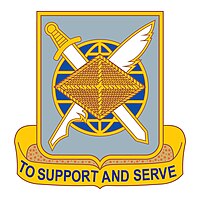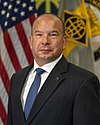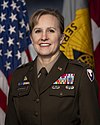U.S. Army branch charged with financial operations
Military unit
The United States Army Finance Corps is a combat service support (CSS) branch of the United States Army. The Finance Corps traces its foundation to 16 June 1775, when the Second Continental Congress established the office of Paymaster General of the Army.[1] The Pay Department became a separate department in 1816, and the Finance Department was created by law on 1 July 1920.[2][1] It became the Finance Corps in 1950.[3] It is responsible for financial operations, most notably payroll and resource management.
Finance Corps units
Corps-level financial management formations exist in Europe, South Korea, as well as at Fort Liberty, North Carolina, and at Fort Cavazos, Texas.
The 18th Financial Management Support Center (18 FMSC) provides financial management services to the units of the XVIII Airborne Corps. It is based at Fort Liberty, North Carolina and its higher headquarters (HQ) is the 1st Theater Sustainment Command (1st TSC) Fort Liberty, North Carolina. The 18th FMSC is responsible for the 24th Financial Management Company (FMCO), the 33rd FMCO, the 82nd FMCO, the 101st FMCO, and the 126th FMCO.[4]
The mission of the 18th Financial Management Center is:[5]
- Rapidly deploy as part of the crisis response force by air, sea and land anywhere in the world.
- Provide financial management support for joint and combined operations (Central Funding, Disbursing, Accounting, Vendor Services, Policy and Internal Controls).
- Provide technical oversight and coordination to designated CONUS-based Financial Management Companies preparing to deploy in concert with the Army Force Generation Cycle.
- Direct employment of non-deployed FM Companies in support of the Installation finance mission in accordance with Assistant Secretary of the Army (Financial Management and Comptroller) (ASA FM&C) guidance
In early 1998 the Commanding General of United States Army Forces Command approved a request from the CG, XVIII Airborne Corps to combine the 18th Finance Group and the 18th Personnel Group (Airborne); to establish a provisional 18th Soldier Support Group (18th SSG) at Ft. Hood; to form SSBs at Forts Stewart, Drum and Campbell; and, to combine the two remaining Finance Battalions at Ft. Bragg.[6] The General Officer Steering Committee (GOSC) did not support the XVIII consolidations as proposed. This decision was made without the benefit of the TRADOC force development process which was Phase 2 of the Service to the Soldier Study. It was not a foregone conclusion that SSBs and SSGs would be implemented Army-Wide. FORSCOM and XVIII Airborne Corps were forging ahead of the Soldier Support Institute study as it was expedient to do so due to the impending force reductions.
Other higher finance formations include:[5]
Battalions and sections
- 9th Finance Battalion
- 24th Finance Battalion
- 25th Infantry Division Finance Section
- 27th Finance Battalion
- 30th Finance Battalion
- 39th Finance Battalion
- 49th Finance Battalion
- 82nd Finance Battalion
- 101st Finance Battalion
- 105th Finance Battalion
- 106th Finance Battalion
- 107th Finance Battalion
- 125th Finance Battalion
- 126th Finance Battalion
- 126th Finance Section
|
- 130th Finance Battalion
- 147th Finance Battalion
- 158th Finance Battalion
- 176th Finance Battalion
- 177th Finance Battalion
- 230th Finance Battalion
- 267th Finance Battalion
- 325th Finance Battalion
- 338th Finance Battalion
- 374th Finance Battalion
- 376th Finance Battalion
- 395th Finance Battalion
- 453rd Finance Battalion
- 501st Finance Battalion
|
Army Reserve & National Guard
- 368th Finance Battalion (USAR) (Wichita, Kansas)
- 469th Financial Management Support Center (USAR) (New Orleans, Louisiana)
- 336th Financial Management Support Center (USAR) (Lake Charles, Louisiana) (Supports Operation Bright Star)
- 326th Financial Management Support Center (USAR) (Los Angeles, California)
- 398th Finance Management Support Center (United States Army Reserve) Fort Belvoir VA, a Major Subordinate Command under the 99th Regional Readiness Center.[7][8]
- 27th Finance Battalion (NYARNG)
- 28th Finance Battalion (PAARNG)
- 40th Finance Battalion (CAARNG)
- 49th Finance Battalion (TXARNG)
- 50th Finance Battalion (NJARNG)
- 138th Finance Battalion (INARNG)
- 153d Finance Battalion (FLARNG)
- 210th Finance Battalion (MSARNG)
- 726th Finance Battalion (MAARNG)
- 93rd Financial Management Support Unit (GA)
- 149th Financial Management Support Unit (TXARNG)
- 249th Financial Management Support Unit (TXARNG)
- 224th Financial Management Support Unit(CAARNG)
- 374th Financial Management Support Unit(MDARNG)
- 376th Financial Management Support Unit(WIARNG)
- 395th Financial Management Support Unit(UTARNG)
- 147th Financial Management Support Detachment (MNARNG)
- 247th Financial Management Support Detachment (MNARNG)
- 1863rd Financial Management Support Detachment (ILARNG)
List of commanders
| No.
|
Commanding General
|
Term
|
| Portrait
|
Name
|
Took office
|
Left office
|
Duration
|
| - | | Lieutenant General
Paul A. Chamberlin | August 3, 2021 | Present | ~2 years, 125 days | https://www.asafm.army.mil/Biographies/Display/Article/2846131/lt-gen-paul-a-chamberlain/ |
| - | | Brigadier General
Mark S. Bennett | October 25, 2019[9] | May 7, 2021[10] | 1 year, 194 days |
| - | | Barry W. Hoffman
Acting | May 7, 2021 | July 15, 2021 | 69 days |
| - | | Brigadier General
Paige M. Jennings | July 15, 2021[11] | June 18, 2024 | 2 years, 339 days |
| - | | Colonel
Michelle M. Williams | June 18, 2024[12] | Incumbent | 212 days |
References
External links






